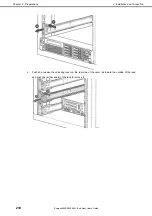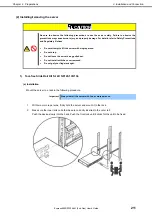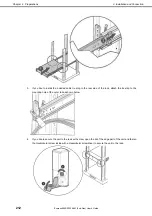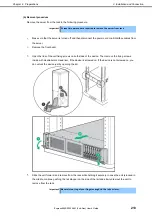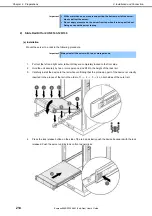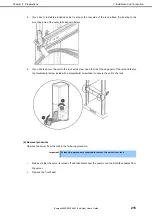
2. Installation and Connection
Express5800/R120h-2M (2nd-Gen) User’s Guide
200
Chapter 2 Preparations
Do not install the rack or server under the following environment. Doing so may cause malfunction of the server.
Narrow space from which devices cannot be pulled out from the rack completely
Place that cannot bear the total weights of the rack and devices mounted on the rack
Place where stabilizers cannot be installed or where the rack can be installed only after the practice of
proper earthquake-resistant construction
Place of uneven or slanting floor
Place of drastic temperature change (near a heater, air conditioner, or refrigerator)
Place where intense vibration may be generated
Place where corrosive gases (sulfur dioxide, hydrogen sulfide, nitrogen dioxide, chlorine, ammonia, ozone,
etc) exist. Place where the air (or dust) includes components accelerating corrosion (ex. sulfur, sodium
chloride) or conductive metals
Place where chemicals may be accidentally sprayed over
Place where a carpet not subject to anti-static process is laid
Place where some objects may be fallen on the rack
Place near a device generating intense magnetic field (such as TVs, radios, broadcast/communication
antennas, power transmission wires, and electromagnetic cranes) is placed.
Place where the power cord of the server must be connected to an AC outlet that shares the outlet of
another device with large power consumption
Place near equipment that generates power noise (e.g., contact spark at power-on/power-off of commercial
power supply through a relay).
Environment
where
operation
of the server is not guaranteed
Space and air flow requirements
For easier repairing and improvement of ventilation, follow the space requirements when you determine the
install location of the rack.
Make a clearance of 63.5 cm (25 in.) or more on the front side of the rack.
Make a clearance of 76.2 cm (30 in.) or more on the back side of the rack.
Make a clearance of 121.9 cm (48 in.) or more between the back side of the rack and the back side of the
other racks or the rack row.
This server take in cold air from the front and discharge the hot air inside from the rear. Therefore, adequate
openings able to absorb the air into the cabinet and discharge the heat are required at the front and rear of rack.
Note
To prevent improper cooling situations or damages to the equipment, do not block
the ventilation openings.
If a server or rack component is not installed on every shelf in the rack, the air flow through the rack or the server
will change because the shelf is empty. To maintain adequate ventilation, blank panels should be covered on all
the shelves that do not have components installed.
Note
Blank panels should be used to cover on all the shelves that do not have
components installed. This ensures the adequate ventilation. If a rack without a
blank panel is used, high-temperature damage may occur due to improper
cooling.

























